TURKEY BY LAND
Although it was never part of ‘the plan’, we flew in to Turkey and arrived in Istanbul. Because neither of us had been to Istanbul before, we chose to stay in the most historic section of the city – Sultanahmet.
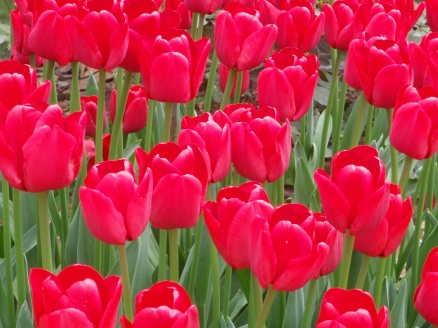
4 million tulips in bloom
We had found a hotel online that was appealing – Berce Hotel (www.bercehotel.com) – and it turned out to be a jewel. It is only seven rooms, and the staff is superb. It is located just a few minutes walk from the heart of Sultanahmet on the point where the Sea or Marmara meets the Bosphorus. We started our days with coffee and breakfast in their lovely little breakfast room that overlooks the Sea of Marmara. (Whatever you’ve heard about Turkish coffee – forget it. These are tea drinkers, and you can get ‘western coffee’ only in hotels!) We had a very good stay with them.
Sultan Ahmet I built the Blue Mosque from 1609 to 1616. This mosque is named the Sultanahmet Imperial Mosque, but it is called the Blue Mosque because of its interior decoration with blue tiles. It is a truly magnificent sight!
From afar one sees a large visual cascade of domes and semi-domes. There are also six minarets. This large number of minarets was considered somewhat sacrilegious when the mosque was built as some thought it an ostentatious rival to Mecca. Each minaret has two or three balconies. On looking closer, there are courtyards and ablutions fountains around the exterior.
Inside one realizes why this is called the Blue Mosque. There are tens of thousands of 17th century blue Iznik tiles and 260 windows, and they create a blue hue throughout the mosque. There are also chandeliers and 17th century stained glass. And it is still a functioning mosque.
Although the Blue Mosque impressed us as particularly beautiful, we found it even more so at night. The exterior is lit with flood lights, and it is beautiful.
Hagia Sophia is known as the “Church of Holy Wisdom”. It was built by Emperor Justinian and completed in 537. He intended this church to demonstrate the greatness of the Roman Empire, and it did. This was the greatest church in Christendom until the conquest in 1453.
Mehmet the Conqueror converted the church to a mosque in the 15th century. Minarets and ablution fountains were added, and the tombs around the building began to be developed. It remained a mosque until 1935 when Ataturk proclaimed it a museum.
Hagia Sophia is characterized by massive domes – 184’ high – without obvious support. This is an impressive architectural achievement, especially considering that it was built more than 1400 years ago. It is also characterized by fine mosaics that have endured for centuries.
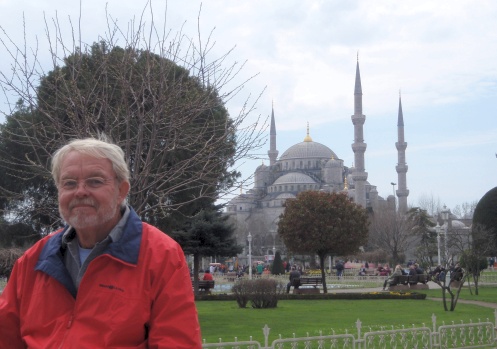
Blue Mosque
The Hippodrome was originally laid out by Emperor Septimus Severus during the rebuilding of the city in the 3rd century. It was a public square and huge stadium that held up to 100,000 people in two levels of galleries. It was oval in shape, and it was the site of chariot races among many other uses.
The Hippodrome was actively used by both Byzantines and Ottomans for about 1,600 years. However, today, only four monuments remain – German Fountain of Wilhelm II, the Obelisk of Theodosius, the Serpentine Column, and the Column of Constantine. The rest of the area is now a walkway through the Sultanamet part of the city – known as Sultanamet Square – and one must look closely for remnants of its original structure. Reportedly the original track is more than six feet below today’s ground level.
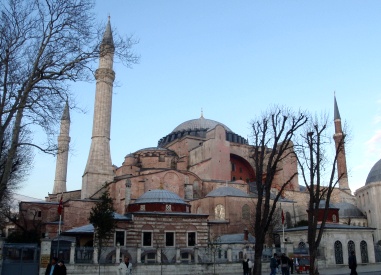
Hagia Sophia
Istanbul’s Grand Bazaar, originally built in 1464, continues to grow and thrive. It is today one of largest covered markets in the world. It is a labyrinth of walkways and corridors housing more than 4,000 shops on 64 streets with 22 gates leading in and out of the bazaar. It is busy, noisy, and vibrant.
Vendors sell everything from trashy souvenirs to fine jewelry. And there is some organization to the layout of shops. There is a goldsmiths’ street, a leather clothing area, and of course, too many carpet shops. There are also mosques, restaurants, and police stations. It can be a bit confusing to find one’s way around, but one can find just about whatever they are looking for there.
We planned to visit Topkapi Palace, and we headed that way. But we got sidetracked by the Archeological Museum, and it was a great stop. Given the long history of civilizations in this area, there has been an abundance of archeological finds, and the museum is rich in historical artifacts.
The museum was established in the 19th century to organize the palace collections; however, it has greatly expanded since then. There are now 20 galleries in three buildings.
We actually found the collections somewhat overwhelming. We were very impressed with the first few classic statues we looked at, but we became numb to their significance after viewing literally hundreds of them. It is far too much to absorb in one visit.
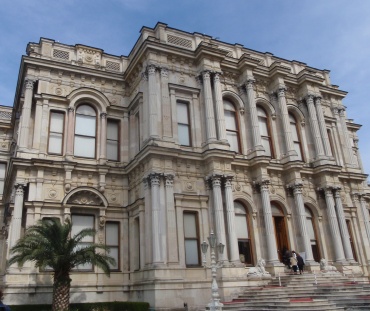
Beylerbeyi Palace
Mevlana Jalaluddin Rumi was an early 13th century Sufi mystic. He was also the founder of the Mevlevi order of Islam – that which is now known as whirling dervishes. Although Rumi was also a prolific author, he is best known for his development of the practice of sema – the whirling ceremony which represents a union with god. Everything about the sema is symbolic – the music, clothing, movements.
We went and watched them, well, whirl. It was interesting for about ten minutes, but the ceremony lasted an hour, and it got a bit boring. It is, after all, a religious ceremony rather than an entertainment performance.
This L-shaped building was built in the 1660s as an extension of the New Mosque. At that time, revenues from the bazaar went to the mosque. It was later called the Egyptian Market because it sold many good from Cairo, but today it is known as the Spice Bazaar.
Most shops sell spices, nuts, honey, or fruits. There are a few restaurants, and there is a small outdoor produce stall.
We found far too many shops selling trashy souvenirs, and the sellers were a bit aggressive. We did not enjoy the spice bazaar other than the smells, and it did smell wonderful.

We paid our respects to Poseidon
This was a bit touristy (and very cold), but we really enjoyed getting on a big tour boat and traveling up and down the Bosphorus. From the boat we saw the Fortress of Europe, the Fortress of Asia, Dolmabahce Palace, and countless mosques in the distance.
We hope to sail through here ourselves within the next year, and we considered this a scouting trip. It is not nearly as intimidating as we thought it might be. You just need to watch where you are going rather than gawking at the countless sights along the shore.
This palace, on the Asian side of the Bosphorus, was built for Sultan Abdul Aziz in the 19th century. However, many of its lush gardens date back to the 17th century.
This was a summer residence for some of the Ottoman sultans, and it is furnished with many of its original furnishings. The original furnishings give this palace an air of authenticity that allows the visitor to get a feel for life in that place at that time. It was easy to imagine wiling away hot summer days there.
Many historical figures have wiled away summer days there. It has an impressive list of past guests.
This was just for the view. Camlica, on the Asian shore of the Bosphorus, is the highest point in Istanbul, and the view from there is magnificent!
Cappadocia is a region, rather than a city, in Central Anatolia. The draw in Cappadocia is fairy chimneys and underground cities. These were enabled by volcanic eruptions around 30 million years ago that blanketed the region with ash. That ash solidified in to easily eroded material called ‘tuff’ with some areas also covered by hard volcanic rock. Over time, the tuff eroded away in various patterns creating ‘fairy chimneys’ as tall as 130’. The softness of tuff made it easy to excavate, and areas were carved out of the tuff to create caves ranging from small houses to large underground cities.
Although the area has been settled since around 1800 BC, it has been attracting tourists only since the 1980s. There are a few small cities within the region, and Goreme is considered the center of the region, so we chose to visit there.
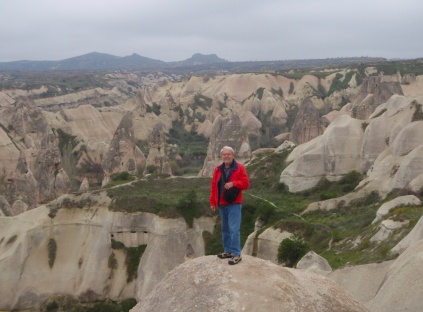
Surreal Cappadocia terrain
We flew from Istanbul to Nevsehir on Turkish Airlines – a very good airline. We took a shuttle to our ‘cave hotel’ that we had booked on-line.
Cave hotels have been excavated in to the tuff, and they are the norm in that area. They are caves with a few amenities added, and our particular hotel – Lalezar Hotel – did not have quite enough amenities for our comfort. Our biggest problem was a lack of hot water (seemingly common in many Turkish hotels), and it was much too cold to shower in cold water. But the hotel was right in Goreme, and it was easy to get around town.
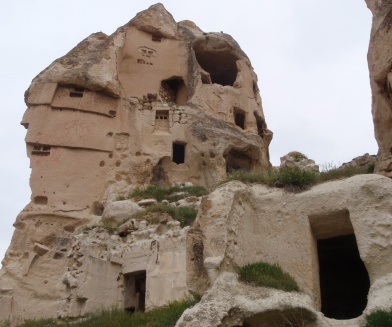
Rock-cut caves all around
We walked to the open air museum which is a world heritage site – and deservedly so. This was originally a Byzantine monastic settlement, and it is a collection of more than 30 rock-cut churches, chapels, and monasteries dating from the 9th century onwards. Many of these have tombs and frescoes that have endured the centuries. The valley walls are honeycombed with small entrances leading to cells previously occupied by monks.
There are well-worn loops to either the north or south with sights along the way. We took the southern loop, and we were not disappointed. Although we stopped at recognized ‘sights’, we were also taken with the scenery along the way. This is an instance of the journey being as interesting as the destination. There were numerous panoramas with unreal scenery.
There were more than 200 underground cities built in the area during the 6th and 7th centuries. Derinkuyu (deep well) is one of thirty seven that have been excavated and opened to the public. It was not at all what we expected.
We read that varying populations from 10,000 to 20,000 lived in Derinkuyu at various times. We expected large areas to accommodate large numbers of people, but what we found were small convoluted tunnels leading to small areas carved out of the tuff. But it was a complete city including stables, a morgue, churches, granaries, wine-making, etc. It is linked to another underground city, Kaymakli, by a six-mile underground tunnel, but we did not see this.
This particular city is 8 levels deep, and its deepest area is 197’ below ground. It is remarkably well ventilated, but it is still a bit too confining. It is difficult to imagine 10- to 20,000 people in there!
Ihlara Valley
Ilhara Valley is a nine mile steep-sided canyon along the Melindiz River. There are four walkways leading down to the river from the canyon rim so that one can hike as much or as little of the canyon as they want. We started in the southern half of the canyon, and we took 360 steps down from the rim. We hiked only a bit over two miles from south to north along the west bank of the river. Along the way were a few rock-cut churches dating to the 11th century, and there were numerous small dwellings carved in the canyon walls. We stopped for a nice riverside lunch at Belisirma. We would have enjoyed spending more time in this peaceful canyon.
Selime Monastery, at the northern end of Ilhara Valley, was carved from the tuff in the 13th century. It is the largest rock-cut monastery in Cappadocia. There are numerous chambers – some being very simple caves cut from the rock and others having ornate columns and details. There are kitchens with chimneys, churches with galleries, and stables with carved feed troughs. Tunnels connected some, but not all, of the rooms, making it great fun to explore.
We wanted to take the bus to Antalya then Finike to check out two marinas and visit friends, but the only option was an overnight bus. We had both been sick, and we did not want to do the overnighter, so we flew back through Istanbul then to Dalaman Airport – the nearest airport to Marmaris. But we were not quite ready to stop our exploring and head to Marmaris. Marmaris is to the northwest, so we went southeast for our first visit to the Mediterranean coast.
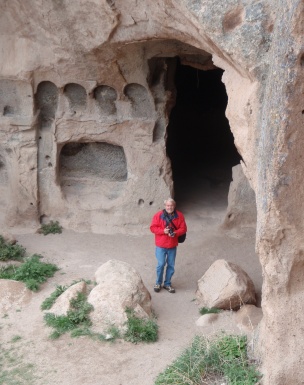
Outside Selime Monastery
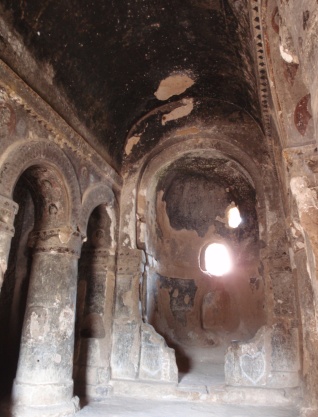
Rock-cut chapel at Selime Monastery
We went to a small village called Yaniklar Koyu – between Gocek and Fethiye – and stayed at a beautiful little lodge called Yonca Lodge. It is right on the Mediterranean coast. It is run by a young couple, and it was a peaceful respite in our hectic travels.
We were the only guests there our first night, and our room opened on to the coast. The home-cooked food and service were both excellent.
We walked along the beach, and we found ruins wherever we looked. We dipped our toes in the Med for the first time, and it was very cold. We walked through the closest village, and the people were remarkably friendly. We also walked along the river that runs through the village in to the sea. We probably could have stayed here for a few more days, but we got an e-mail advising us that the Everest and Passage would arrive in just a few days, so we quickly headed to Marmaris to be ready and waiting when she arrived.
When we got to Marmaris, we went to the marina to check it out and make arrangements for a berth for Passage. We discovered they had rooms for rent, so we decided to stay there for the few nights until Passage was in the water. The rooms were miserable. They were dirty and, again, no hot water. But it was convenient. Then we were told there would be a few days’ delay in the Everest arriving, so we moved to town.
We went to the Royal Maris Hotel. This was not a bad hotel, and it had hot water, so we were content. We had a view of the bay, and we monitored e-mail and watched for the ship to come in. We were getting anxious.
We finally saw the BBC Everest arrive in the early morning on April 29. We raced off to the dock. A few boats were off-loaded on the 29th, and the plan was to off-load the rest of them on the 30th, but the weather changed that. A gusty thunderstorm blew in, and it was too rough to continue. So we returned to the Royal Maris for one more night. We were off-loaded on May 1. Oh happy day…
We did not settle in here too easily. It is unbelievably crowded – to the point of being unsafe – and there are many other annoyances. We thought that we would probably want to be elsewhere for the down time in the winter, so we drove east to check out the marina in Finike as we had hoped to do a few weeks prior.
This was a beautiful drive along the southern coast. The road climbs and drops and turns back and forth along the coastline. Although it took us six hours to get from Marmaris to Finike, we enjoyed the drive.
In Finike we had lunch with our long-time friends, Greg and Debra on SV Sonrisa, whom we had not seen since they left Thailand in March, 2010. We loved seeing Greg and Debra, but we did not like Finike. Oh well, it had been a nice day nonetheless.
We needed to put gas in our little rental car on the way back to Marmaris, and it cost us the equivalent of $10.77 per gallon. This would be our introduction to fuel prices in the Med.
Bud needed to make a trip to the US, and he was gone just under a month. Nita stayed on board and caught up on a few overdue projects.
When Bud returned, we took on our ongoing watermaker issues. In the end, we had to replace the membrane. But we are now making large amounts of excellent quality water, so we are happy.
Because it is so flammable, we gave away all our gasoline (for the outboard engines) before shipping Passage from the Maldives to Turkey (we left a small amount of diesel in the main tanks, but it is much less flammable). So we needed to buy a small amount of gas to take sailing with us for our dinghy. There is no fuel dock at Marmaris Yacht Marine, and there are no fuel stations nearby, so we had a 5 gallon can filled by the local filling service in the marina. It cost us 100 TRY for 5 gallons – the equivalent of $11.90 per gallon. Oh well…
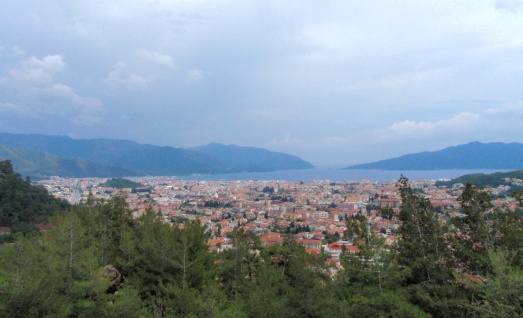
Overview of Marmaris and bay
Time to go sailing!
Follow us as we explore Turkey by sea or return to our general Turkey page.